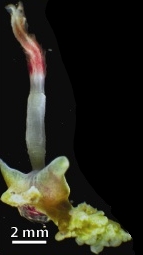Perviata
| Perviata | ||||||||||||
|---|---|---|---|---|---|---|---|---|---|---|---|---|

Osedax roseus |
||||||||||||
| Systematics | ||||||||||||
|
||||||||||||
| Scientific name | ||||||||||||
| Perviata | ||||||||||||
| Jones, 1981 | ||||||||||||
| Superfamilies | ||||||||||||
The Perviata , also Frenulata or Pogonophora in the real sense, are a group of beard worms (Pogonophora) and belong accordingly to the tube-building annelids (Annelida). They live on the seabed of almost all the world's oceans, especially at depths of 1000 m to 10,000 m. The animals are very thin and can reach body lengths of up to 22 centimeters. All beard worms are fed by symbiotic bacteria that convert sulfur compounds into organic nutrients.
features
Perviata have a diameter between 0.1 and 3 millimeters with an average body length of five to 75 millimeters. All species live in tubes.
The perviata have a trunk with numerous protuberances (papillae), annuli with hooks and cilia ligaments . This ends in a rear end ( opisthosoma ), which is segmented and has bristles. The front body has a sloping bar (frenulum) and has a head flap as well as between one and 200 dorsal tentacles , which can be feathered.
The material for the tubes of all beard worms is formed from chitin by gland cells in the epidermis of the beard worms and secreted. In the Perviata, the tubes are mostly embedded in the sediment or other substrates and usually only protrude a little, in Siboglinum poseidoni they are even completely buried. The tubes grow in them as new material is deposited at both ends. The tube is permeable for absorbing substances, so it lets dissolved gases , salts and amino acids through.
Reproduction and development
The fertilization of the perviata takes place in the tube of the female. Here the eggs in the tube develop via a spiral furrow into a ciliated larva, which is free-swimming for a short time and then settles on the bottom. A ciliate stage with one or two tentacles first develops, later the body differentiates into the various body regions. The tube is already deposited during this development.
distribution and habitat
Most of the known 140 species live in the western Pacific and in the deep oceanic trenches, but some species are also at home in Greenland , New Zealand , the Indian Ocean and the northeast Atlantic .
Beard worms have so far been detected at depths of 25 to over 10,000 meters, but mostly in the deep sea .
literature
- Purschke G (1996): Pogonophora, beard worms , in Westheide W, Rieger R: Special Zoology, Part 1: Protozoa and invertebrates , Spectrum Academic Publishing Heidelberg
- Ivanov AV (1963): Pogonophora , Academic Press London
- Nørrevang A (1975): The phylogeny and systematic position of POgonophora , magazine for zoological systematics and evolutionary research, special issue 1